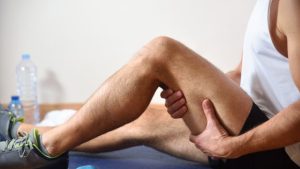In the pursuit of fitness goals, injuries can be an unfortunate and frustrating setback. Whether you’re a seasoned gym-goer or a beginner, injuries can occur, disrupting your routine and progress. However, with the right approach, you can recover effectively and get back to your fitness journey. This guide will explore how to recover from injuries sustained during workouts and provide valuable tips to help you prevent them in the future.

Understanding Common Gym Injuries
Before diving into recovery strategies, it’s essential to understand the types of injuries you might encounter at the gym. Common injuries include:
1. Strains and Sprains: These involve the overstretching or tearing of muscles (strains) and ligaments (sprains). They often result from improper technique, sudden movements, or overuse.
2. Tendinitis: This is the inflammation of a tendon, usually caused by repetitive motions. It’s commonly seen in areas like the shoulders, elbows, and knees.
3. Fractures: These are less common but can occur due to falls or dropping heavy weights. They require immediate medical attention.
4. Dislocations: These happen when bones are forced out of their normal position. Like fractures, they need urgent care.
5. Back Injuries: Improper lifting techniques can lead to herniated discs or muscle strains in the back.
Steps to Recover from a Gym Injury
1. Seek Medical Attention: The first and foremost step is to consult a healthcare professional. They can accurately diagnose the injury and recommend appropriate treatment. For severe injuries like fractures or dislocations, immediate medical attention is crucial.
2. Rest and Immobilization: Give your body the time it needs to heal. Resting the injured area prevents further damage and promotes recovery. Depending on the injury, you might need to use braces, slings, or crutches to immobilize the area.
3. Ice and Compression: Applying ice packs to the injured area helps reduce swelling and inflammation. Use a cloth to protect your skin and apply ice for 15-20 minutes several times a day. Compression with bandages can also help control swelling.
4. Elevation: Elevating the injured limb above heart level can reduce swelling. This is particularly useful for injuries to the legs or arms.
5. Physical Therapy: Once the initial swelling and pain subside, physical therapy can aid in the recovery process. A trained therapist will guide you through exercises to restore strength, flexibility, and range of motion.
6. Gradual Return to Activity: Rushing back to your usual workout routine can lead to re-injury. Gradually reintroduce physical activity, starting with low-impact exercises and progressively increasing intensity.
Tips for Preventing Gym Injuries
While recovery is crucial, prevention is always better than cure. Here are some tips to help you avoid injuries during workouts:
1. Warm-Up Properly: A good warm-up prepares your body for exercise by increasing blood flow to muscles and loosening joints. Spend at least 10-15 minutes on dynamic stretches and light cardio.
2. Use Proper Technique: Poor form is a common cause of injuries. Learn the correct techniques for exercises and avoid lifting weights that are too heavy for you. Consider working with a certified trainer, especially if you’re new to the gym.
3. Listen to Your Body: Pay attention to how your body feels during workouts. If you experience pain, stop the exercise immediately. Pushing through pain can worsen injuries.
4. Stay Hydrated: Dehydration can affect muscle function and increase the risk of cramps and injuries. Drink water before, during, and after your workouts.
5. Cross-Train: Incorporating a variety of exercises into your routine can prevent overuse injuries. Mix strength training with cardio, flexibility exercises, and different activities to keep your body balanced.
6. Take Rest Days: Your muscles need time to recover and repair. Schedule regular rest days in your workout routine to prevent overtraining and reduce the risk of injury.
7. Invest in Good Equipment: Ensure that your workout gear, including shoes, is appropriate for your activities and in good condition. Poor-quality or worn-out equipment can contribute to injuries.
8. Progress Gradually: Whether you’re increasing weight, intensity, or duration, do so gradually. Sudden jumps in your workout load can shock your body and lead to injuries.
Mental and Emotional Recovery

Recovering from a gym injury isn’t just about the physical aspect; it also involves mental and emotional healing. Here’s how to stay positive and motivated during this challenging time:
1. Stay Informed: Understanding your injury and the recovery process can reduce anxiety and help you set realistic expectations. Ask your healthcare provider questions and stay updated on your progress.
2. Set Small Goals: Instead of focusing on the long-term recovery, set small, achievable goals. Celebrate each milestone, no matter how minor it may seem.
3. Stay Engaged with Your Fitness Community: If possible, continue to visit the gym, even if you’re not working out. Engaging with your fitness community can provide support and motivation.
4. Find Alternative Activities: Depending on your injury, you might still be able to engage in other forms of exercise. Swimming, walking, or yoga can keep you active without stressing the injured area.
5. Practice Mindfulness and Stress Management: Techniques like meditation, deep breathing, and visualization can help manage stress and maintain a positive outlook.
6. Seek Support: Don’t hesitate to seek support from friends, family, or support groups. Sharing your experiences and feelings can alleviate the emotional burden of dealing with an injury.
Conclusion
Injuries are an inevitable part of any fitness journey, but they don’t have to derail your progress permanently. By following proper recovery steps, seeking professional guidance, and implementing preventive measures, you can bounce back stronger and more resilient. Remember, the key to a successful recovery lies in patience, consistency, and a positive mindset. Stay committed to your health and well-being, and soon you’ll be back on track, achieving your fitness goals.
If you’re hungry for more tips on optimizing your workouts, exploring new exercises, or delving deeper into nutrition for muscle growth, be sure to check out our other articles.

